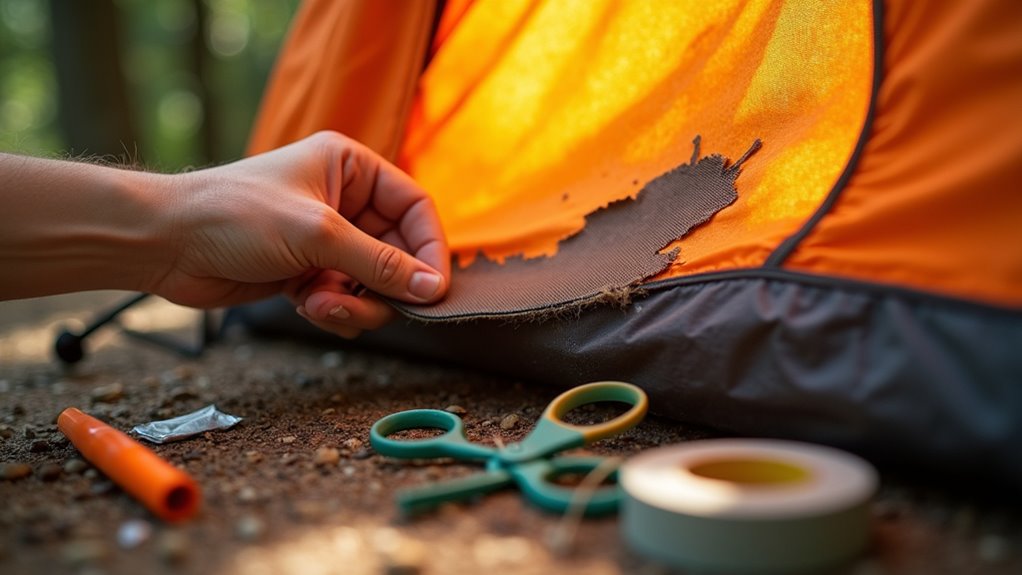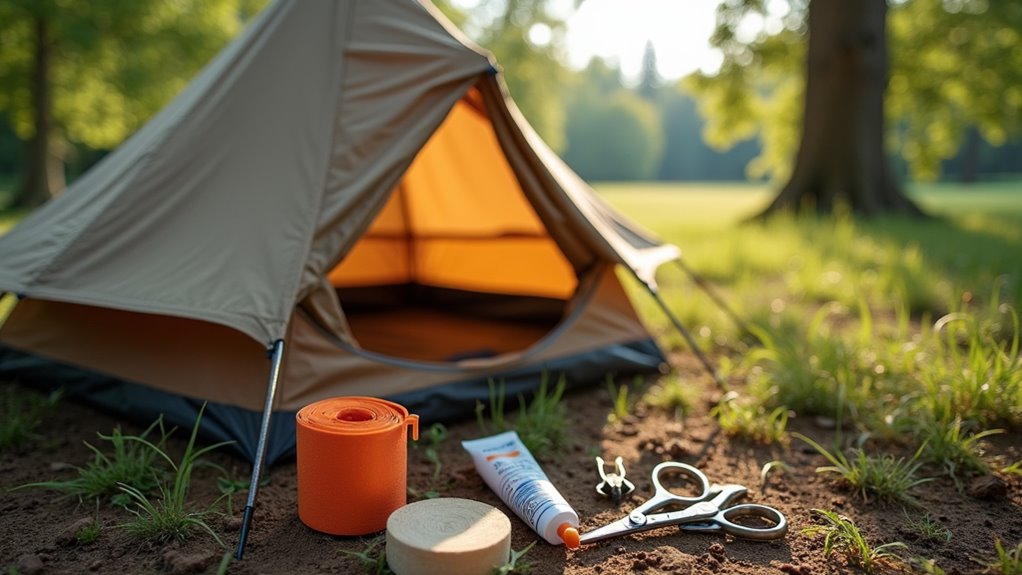How To Patch A Tent
This post contains affiliate links. As an Amazon Associate, we earn from qualifying purchases.
To patch a tent effectively, clean the damaged area, apply a suitably sized patch, and press it firmly to ensure good adhesion. Using strong repair tapes like Tenacious Tape™ or Tear-Aid Type A, or waterproof glue such as Seam Grip for larger tears, will provide the best results. Further details on preparation, application techniques, and essential repair supplies will be explained later in the article for those interested in a more thorough understanding.
Essential Facts in 30 Seconds
- Clean and dry the damaged tent area before patching.
- Cut a patch at least one inch larger than the tear with rounded corners.
- Use strong repair tape or waterproof glue and press firmly to avoid air bubbles.
- For large tears, apply double-sided patches overlapping by 1.5 to 2 inches.
- Check regularly for small holes and use silicone-based seam sealant for waterproofing.
Preparing the Tent for Repair

Prepare the tent fabric on a flat, stable surface with good light. Gather rubbing alcohol, clean rags, scissors, and repair tape nearby. This saves time and helps you stay organized.
Clean the area around the tear well using a rag and rubbing alcohol. Dirt and oil block the patch from sticking. Don’t use soaps because they leave residue. Regularly checking for leaking seams can help prevent damage before it occurs.
Mark the patch’s edges with a pencil. Make the patch at least one inch bigger than the tear. Pull the fabric tight to avoid bubbles. This keeps the patch strong. Additionally, ensure the materials used for the patch are suitable for the tent material, as this will enhance the effectiveness of the repair.
These steps help your tent repair last longer and work better.
Repair Methods for Tent Fabric Tears
Tears in tent fabric need strong and lasting repairs. Use heavy-duty polyester or waxed thread for sewing. Lock-stitch or backstitch works best. Keep stitches short and neat. It’s essential to assess the damage before choosing a repair method to ensure the best outcome.
Add a whip stitch around edges to stop fraying. For fast fixes, use waterproof and flexible glue like Seam Grip. Large tears need double-sided patches on both sides. Let patches overlap the tear by 1.5 to 2 inches. Clean the area with rubbing alcohol before gluing, as this will enhance patch adhesion.
Fabric repair tape, like Tenacious Tape, suits small to medium tears. Cut tape with rounded edges to avoid peeling. Ensure a clean surface for better patch adhesion before applying any repair materials. Let patches dry completely before using the tent again. This keeps your tent strong and ready for adventure.
Patching Process and Materials

Patching a tent takes care and the right tools. Clean the damaged area with rubbing alcohol. Make sure it’s dry and free of dirt. Properly assessing damage can help you determine the best method for patching.
Use strong tapes like Tenacious Tape™ or Tear-Aid Type A. These work well on many tent fabrics. Use mesh patches for torn mesh areas. This keeps air flowing and closes holes neatly.
Pick glue that’s waterproof and resists sunlight. HH-66 Vinyl Cement works for vinyl tents. Tear Mender suits other materials. For effective repairs, cut the patch so it covers the hole with at least a one-inch border. Round off the patch corners to stop peeling. Press the patch down hard to remove air bubbles. Let the glue dry for 24 hours before using the tent. Regularly cleaning zippers can help prevent dirt buildup and maintain smooth operation. Fix tents only when the fabric is clean and dry. This helps the patch stick well.
Repairing Small Holes and Pinhole Leaks
Small holes and pinhole leaks can cause big problems later.
Clean the area around the hole well with rubbing alcohol or soapy water. Dry it completely to help the patch stick better.
Cut a patch at least one inch bigger than the hole on all sides. Press the patch inside the tent firmly, using a spoon to push out air bubbles. It’s also important to inspect seams regularly as they are common areas for leaks.
Apply silicone-based seam sealant over the patch. Make sure the sealant covers the edges for a strong, waterproof hold. Regularly check the canvas for new wear or damage to ensure long-lasting protection.
Let the patch dry fully before using the tent again. Check your tent often for small holes to keep it strong and last longer.
Tools and Essential Repair Supplies

Right tools and supplies make tent repairs easy and strong. A good repair kit should have nylon tent patch tape for tough, waterproof patches. Add seam sealer to keep patched spots dry. Carry a pole splicer to fix broken tent poles. Bring spare buckles and grommets for gear repairs.
Basic tools help a lot. A hammer and screwdriver fix hardware. Scissors or shears cut fabric cleanly. Pliers bend metal parts. A multi-tool or knife comes in handy for many tasks. Use adhesives like Tenacious Tape™ or Aquaseal + UV for strong, flexible seals. Additionally, having a repair sleeve on hand can provide extra support for damaged tent poles.
Keep repair tape strips, nylon cord for guy lines, and extra batteries for lanterns ready. These tools and supplies prepare you to fix almost any tent problem quickly. Ready for the outdoors and any repair challenges.
Frequently Asked Questions
Can I Use Regular Tape for Tent Repairs?
Regular tape can fix a tent for a short time. It sticks well on dry surfaces but may peel off when wet. Outdoor tapes, like duct tape or tent repair tape, last longer. They resist water and hold better on fabric. These tapes cost a bit more but save money by avoiding big repairs. Using the right tape keeps your tent strong and safe during trips.
How Long Will a Patch Last on My Tent?
A patch on a tent can last from weeks to years. Sewn patches usually hold much longer than glued ones. Glue patches often peel off in a few weeks, especially in wet weather. Checking your tent often helps spot weak spots early. Proper care, like keeping the tent dry, makes patches last longer. Strong stitches and good-quality patch materials also improve patch life. A well-done repair keeps your tent safe for many trips.
Is It Safe to Wash a Patched Tent?
Washing a tent with patches is safe with care. Muddy trips can make the tent dirty. Hand wash the tent gently to keep it clean. Avoid using machines. Machines can damage patches and remove waterproof coatings. Use mild soap and cold water. Let the tent air dry in the shade. This keeps the fabric strong and water-resistant. Taking care this way helps your tent last longer.
Can I Patch My Tent in Wet Conditions?
Patching a tent in wet weather can be tricky. Water stops glue from sticking well. Try to dry the patch area as much as you can. Use a towel or cloth to remove water. Press the patch firmly to keep it tight. Good patches keep rain out and stop holes from growing. Carry a patch kit with glue and tape for quick fixes. Fix tears fast to protect your tent and stay dry.
What Types of Tent Fabrics Require Special Repair Techniques?
Nylon and polyester tents need sticky patches to fix tears. Canvas tents require strong needles and special tape for repairs. Breathable fabrics need careful mending to keep air flowing well. Using the right method helps tents last longer and work better. Simple fixes can save your tent from big damage.
Conclusion
Patching your tent fixes holes and stops leaks fast. Use strong materials like Tenacious Tape or a fabric patch kit. Clean the damaged spot well before applying the patch. Press the patch firmly and wait for it to stick completely. This keeps your tent safe and ready for your next trip. Simple repairs save money and prevent bigger problems later. Enjoy nature without worry.
